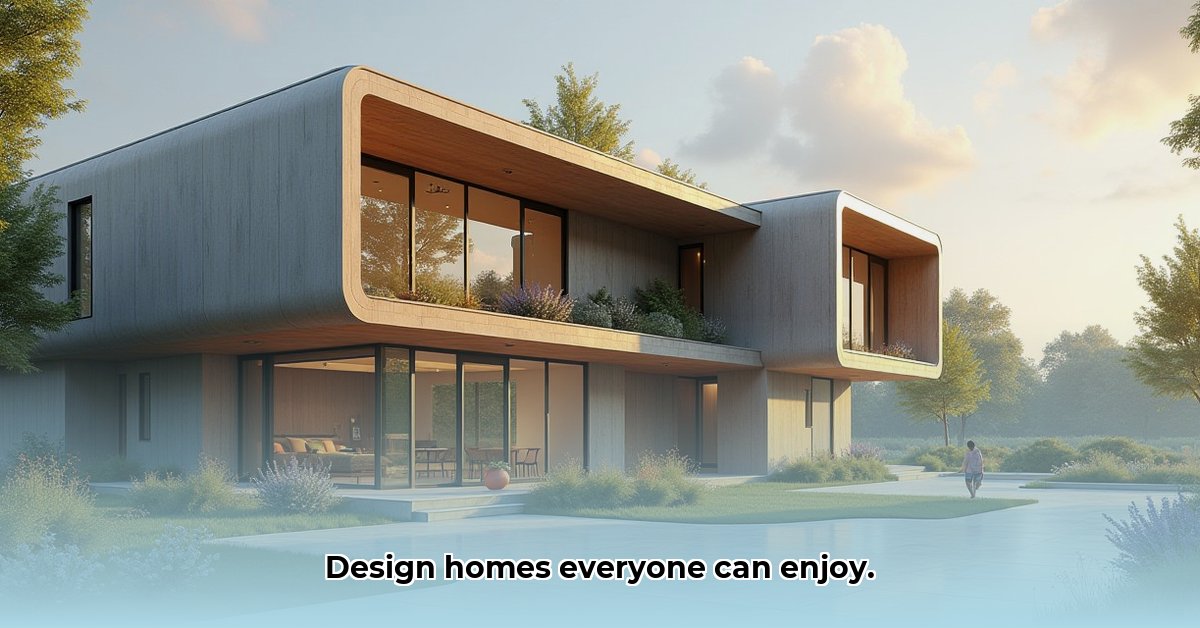Building a home that works for everyone, no matter their abilities, isn’t just about following the rules; it’s about creating a place where everyone feels comfortable, safe, and can live their best life. This guide walks you through designing or updating your home to be more accessible, whether you’re starting from scratch or making changes to what you already have. We’ll cover everything from making bathrooms and kitchens easier to use to adding smart technology and creating accessible outdoor spaces. We’ll show you practical ways to make your home more welcoming for everyone, sharing real-life examples and advice to help you every step of the way. So, whether you’re building a new house or updating your current one, let’s create a space where everyone can thrive. For more on aging in place, see this helpful guide: Aging in Place Design.
Accessible Home Design for Disabilities: A Focus on Independent Living
Building or adapting a home to be accessible isn’t just about ticking boxes; it’s about making a space that truly works for everyone, boosting independence, and improving quality of life. It’s a thoughtful process, and we’ll break down how to make it happen, ensuring universal design principles for all. Consider it an investment in long-term well-being and comfort for yourself and your loved ones. Accessibility also increases your home’s future market value.
Key Design Principles for Accessible Living Spaces with Assistive Technology
Let’s dive into the practical elements of designing or modifying a home for accessibility. Remember, it’s all about creating a comfortable and safe environment where everyone feels at home, promoting age-in-place solutions.
1. Smart Space Planning: Making Room for Everyone
Think about how people move through the house. Wide hallways (at least 36 inches wide – that’s about the width of a standard doorway) are crucial, especially if someone uses a wheelchair. Doorways should also be at least 36 inches wide to allow for easy passage. Consider the turning space needed for wheelchairs – you’ll want enough room for comfortable maneuvering. A 5-foot turning radius is generally recommended. Flexible layouts, with adjustable shelving and furniture, are a big plus because needs evolve over time. Open floor plans can significantly improve maneuverability. Visual aids, like floor plans showing these clearances, are incredibly helpful in planning.
2. Bathroom Bliss: Safety and Ease of Use
Bathrooms need special attention. Grab bars near the toilet and shower provide much-needed support and stability, preventing falls. Consider installing them during initial construction, even if not immediately needed, as reinforcement within the walls will be necessary. Roll-in showers, without high thresholds, are vastly more accessible than standard showers. Aim for a curbless entry. Toilets and sinks should be at a comfortable height for everyone, minimizing strain. Comfort height toilets (17-19 inches) are often recommended. Prioritize safety features; careful planning can make a huge difference in someone’s independence. Don’t forget about slip-resistant flooring.
3. Kitchen Confidence: Cooking with Ease
The kitchen is the heart of many homes, and making it accessible will enhance daily life. Adjustable countertops are amazing; they allow people of different heights to use the kitchen comfortably. Aim for sections that can be adjusted between 30 and 36 inches. Pull-out shelves and accessible storage make it easier to reach items, reducing strain. Consider placing frequently used appliances within easy reach. Wall-mounted ovens and front-loading dishwashers can also improve accessibility. A well-designed kitchen promotes independence and comfort. Knee space under the sink and cooktop should also be considered for wheelchair users.
4. Lighting and Sensory Solutions: Creating a Calming Environment
Proper lighting is essential. Good, bright lighting reduces shadows and glare to create a safe and comfortable environment. This is especially true in areas where people might have impaired vision. Consider using non-glare surfaces, and consider people with sensory sensitivities. Flooring that minimizes vibrations, such as cork or rubber, can significantly improve comfort and reduce the risk of falls for some individuals. Natural light is also a key component.
5. Smart Home Technology: A Helping Hand
Smart technology offers several ways to assist with daily tasks. Voice-activated controls for lights and appliances can increase independence, and automated blinds increase accessibility. Smart thermostats can also help regulate temperature. However, keep privacy concerns and cost in mind. It’s crucial to choose user-friendly systems that are easy to operate and reliable. Look for systems that integrate well with existing devices and offer strong security features. While technology offers exciting possibilities, it’s important to weigh the benefits against potential drawbacks.
6. Outdoor Oasis: Accessible Landscaping
Don’t forget the outdoors! Ramps provide step-free access to patios and gardens. Ensure they have a gentle slope and handrails. Level pathways ensure smooth and safe transitions, and accessible garden features allow everyone to enjoy the beauty of nature. Raised garden beds are great for those with limited mobility. Think about features that everyone can use and enjoy. Consider automatic sprinkler systems to reduce the need for manual watering.
Retrofitting vs. New Construction: Different Approaches, Shared Goals for Home Modification
Reworking an existing home for accessibility presents unique challenges compared to building from scratch. New builds allow you to incorporate accessible design from the very start, which is often simpler. Retrofitting requires strategic modifications, typically focusing on areas where improvements are most needed. The core difference lies in the level of control you have over the project, depending on whether you start with a blank canvas or are working with an existing structure. Retrofitting may involve compromises due to existing structural limitations.
Budgeting and Resources: Making Accessibility Affordable for Aging in Place
Creating an accessible home involves financial considerations. Explore different funding options, including grants and government programs designed to support accessibility adaptations. Check with your local and state governments for available programs. For complex projects, professional help is invaluable. Occupational therapists can provide expert advice on specific needs. Careful budgeting and planning are essential.
Legal and Regulatory Compliance: Knowing the Rules about Home Safety
Compliance with the Americans with Disabilities Act (ADA) standards, or equivalent local regulations, is crucial. While the ADA primarily applies to public accommodations, understanding its principles can inform your home design. Non-compliance can lead to significant penalties in commercial settings. Consulting with professionals ensures your project meets all requirements and avoids any potential issues with legal standards.
Case Studies: Inspiration from Real-Life Examples of Home Adaptations
Seeing successful accessible home designs in action is incredibly inspiring. Case studies showcase practical solutions and demonstrate how inclusive living spaces are created. These examples offer concrete ideas and boost confidence in the process. Look for examples that match your specific needs and budget.
Choosing Smart Home Technologies: A Detailed Look at Adaptive Equipment
| Feature | Pros | Cons |
|---|---|---|
| Voice Control | Hands-free operation, increased independence | Privacy concerns, reliance on technology, potential for malfunction |
| Smart Lighting | Customizable lighting schemes, energy efficiency | Initial cost, potential technical issues, needs internet access |
| Automated Blinds | Convenience, improved temperature control | Cost, potential for malfunction, internet dependency |
| Smart Thermostats | Remote control, energy savings | Cost, complexity, requires internet |
| Security Systems | Increased safety, remote monitoring | Cost, false alarms, privacy considerations |
Remember, designing an accessible home is an investment in independence, dignity, and a higher quality of life for everyone. It’s about creating a welcoming space where everyone feels comfortable and can live their life to the fullest. It’s a journey toward inclusive living. Start with a comprehensive assessment of needs and priorities.
How to Retrofit a Home for Accessibility on a Budget: Making Every Dollar Count
Key Takeaways:
- Adapting your home for accessibility doesn’t require a fortune. Many improvements are achievable with a reasonable budget.
- Prioritize essential modifications based on individual needs. Focus on the areas that will have the biggest impact. Start small and gradually tackle larger projects.
- Explore various funding options, including grants and government programs, to offset costs. Don’t overlook local charities and non-profit organizations.
- Remember that even minor adjustments can significantly improve safety and independence, such as installing grab bars or lever-style door handles. These small changes can make a big difference.
- Professional guidance can help optimize your plan and ensure compliance with regulations. Even a consultation can provide valuable insights. Is it possible to improve home accessibility without breaking the bank? Absolutely.
Space Planning: Creating Easy Movement with Minimal Cost
First, let’s focus on making movement easier. Think about widening doorways—36 inches is ideal—and creating turning spaces. A 60-inch diameter circle allows for easy wheelchair turns. Hallways need similar consideration. Remove obstacles and ensure adequate lighting. Visualize the flow – you want smooth, unobstructed paths. Adaptable layouts are key, perhaps using furniture that can be easily moved or rearranged. Consider using lightweight furniture with wheels.
Bathroom Accessibility: A Safe and Comfortable Space through Affordable Changes
Bathrooms often require the most significant changes. Grab bars near the toilet and shower are crucial. Install them securely and at the correct height. A roll-in shower, replacing a tub, greatly improves access. Consider lower sinks and toilets for easier use. Non-slip flooring is a must for safety. Look for cost-effective options like textured tiles or non-slip mats.
Kitchen Accessibility: Making Cooking Easier with Smart Renovations
Your kitchen can also be adapted. Adjustable countertops are a major help. Consider a rolling island for extra workspace
- Backsplash For Cooktop: Stylish Ideas To Protect and Enhance - December 25, 2025
- Stove Backsplash Ideas: Find Your Perfect Kitchen Style - December 24, 2025
- Stovetop Backsplash Ideas: Stylish Protection for Your Kitchen Cooking Zone - December 23, 2025










